
views
Feeding and Looking After a Russian Blue

Feed your cat two times a day. The Russian Blue loves food and will often try and trick owners into overfeeding. Do not let this happen because obesity can lead to major health problems, such as diabetes. Because of this, you should stick to scheduled feeding, instead of free range feeding. This way you will be able to monitor your cat’s food intake and will easily notice if your cat begins to eat less, which could be a sign of a health problem. Read the food package to determine how often to feed your cat and much food to give it. Feed your cat a premium, grain-free, dry cat food such as Royal Canin, Halo, or Acana. You can also give your cat more expensive, protein rich, grain-free canned food. Avoid giving a Russian Blue too many treats because they are susceptible to weight gain.
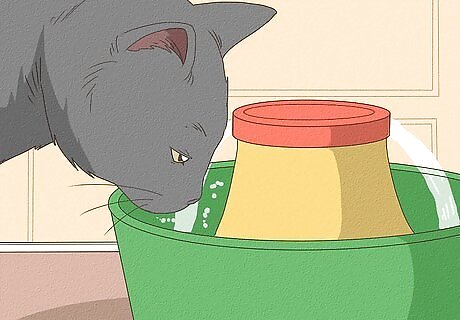
Provide water for your cat. Water is an important part of a cat's diet, and due to their low thirst drive, some cats do not get enough water. As a result, water should be available for your cat at all times throughout the day. If your cat does not get enough water they could develop kidney or urinary tract problems. In order to prevent this, increase your cat's water intake by: Supplementing your cat’s diet with premium, canned cat food mixed with a bit of water. Purchasing a pet fountain from your local pet store in order to make your cat’s water station more attractive. Cats are more likely to drink water that is running or moving. Placing multiple water bowls throughout the house and changing the water daily.
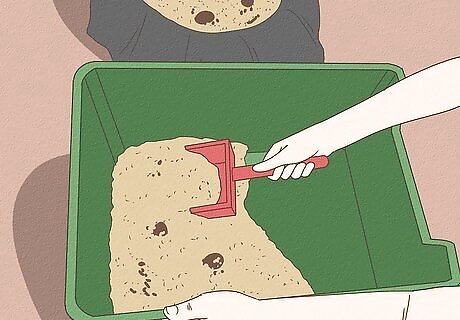
Clean the cat’s litter box frequently. Russian Blues are a very nit-picky breed and many will not even enter the litter box when it is not cleaned. As a result you should scoop out feces daily and fully change the litter box at least twice a week. The Russian Blue is extra particular about hygiene, which means you may have to clean the litter box more frequently. Monitor your cat and find a routine that works. Frequently cleaning the litter box can also reduce smells and odors. Place the litter box in a quiet space, such as a bathroom or laundry room, in order to reduce odors in your living space. It is also important to make sure that the litter box is not placed behind a closed door because the cat needs to be able to access it at all times.
Grooming a Russian Blue
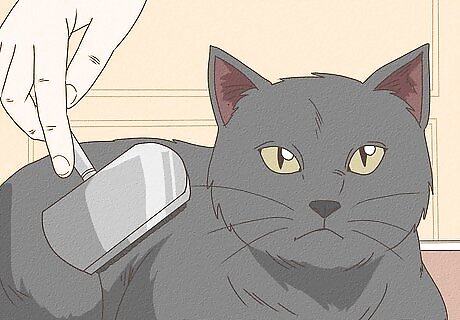
Comb your cat once or twice a week. The Russian Blue is distinguished because of its beautiful grey-blue coat. The coat is called a “double coat” because of the two distinct layers, which make the cats appear much bigger than they actually are. In order to maintain their beautiful, thick coats, you should brush a Russian Blue 1-2 times per week. Russian Blues typically enjoy being brushed because they like the attention. Use a medium to small toothed metal comb. Weekly brushing will help remove any loose hair and can prevent your cat from ingesting a fur ball.
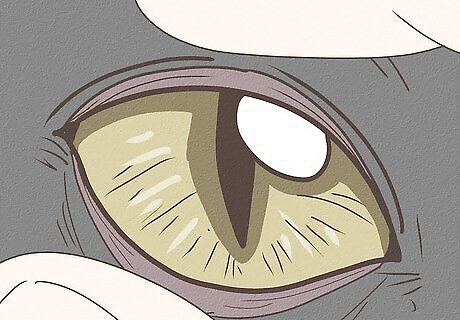
Examine your cat’s eyes. Prior to brushing your cat, get into the habit of doing a quick, at home, eye exam. This will help you identify any potential health issues related to tearing, crust, cloudiness, or inflammation. In order to conduct a basic eye exam follow these steps: In a brightly lit area of the house face your cat directly and look into their eyes. They should look clear and bright, and the area around the cat’s pupils should be white. Roll up your cat’s eyelid with your thumb and examine the lining of the eyelid. It should appear pink in colour, not red or white. Gently remove any gunk or crust from your cat’s eye using a damp cotton ball. Talk to your vet if you notice cloudiness or change in colour, red or white eyelid lining, excessive tearing, and crust build-up.
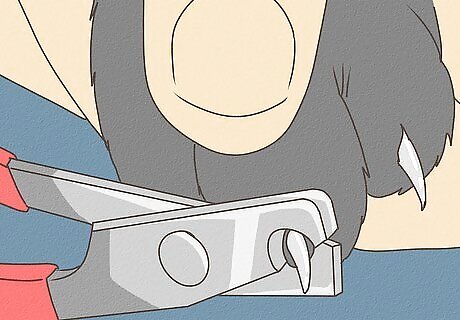
Trim your cat’s nails. Cat’s should have their nails trimmed every 10 days to 2 weeks, in order to avoid splitting and breaking. The best way to trim a cat’s nails is to find a quiet, stimulus free area of your house. Do not try and clip your cat’s nails in front of a window because they may get distracted by animals or sounds outside and try to leap out of your arms. Cradle the cat in your lap and gently press the bottom of their pads so that they display their nails. Russian Blues have clear or translucent nails, which makes it easier to see the pink vein (or quick) that runs about half-way down the nail. Using a pair of nail clippers that can be purchased at a local pet supply store, clip the nail just below the pink vein. Do not clip the vein because this will cause the cat to bleed, be in pain, and likely not trust you to cut it’s nails in the future. If you do accidentally cut the vein while trimming your cat's nails, you can stop the bleeding by using styptic power. This powder can be purchased at your local pet supply store. You can give your cat a small treat following the nail clipping to reward them for good behaviour.

Examine your cat’s ears. It is also important to check your cat’s ears periodically for wax build-up and any other health issues that may develop. Examine their ears weekly. If you notice any wax build up, simply place some olive oil on a Q-tip and swab out the ear. In addition to wax removal, pay attention to the following signs when conducting an ear exam: Persistent scratching of the ears. Redness and swelling. Black or yellow discharge. Odors. Hearing loss. If any of these occur talk to your vet immediately.
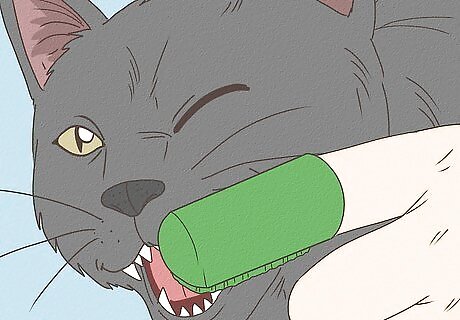
Brush your cat’s teeth. In order to keep your cat in overall good health, brush their teeth once per week. Talk with your vet in order to find out what toothpaste and brush they recommend. You can purchase feline toothpaste and toothbrushes at your local pet store. Gently brush your cat’s teeth. In order to get the cat comfortable with this process you will need to introduce the brush and toothpaste slowly over time.
Socializing and Playing with a Russian Blue
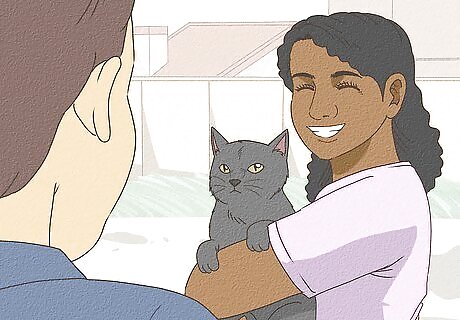
Introduce your cat to new people, pets, and places slowly. Russian Blues are fairly timid and can take a while to adjust to new people, places, and pets. They like routine, and anything out of the ordinary can cause them stress. When you first get a Russian Blue, you should slowly introduce it to your family members and home environment. For example, try confining the cat to one room for a few days, until they are completely comfortable with you and have adjusted to the environment. If you have another pet, you should keep them separated in the beginning until they have had a chance to learn each others scents in a non-threatening manner. When you have guests over, your Russian Blue is likely to hide initially. Your cat may venture out for a visit once they have deemed the guests safe and non-threatening.
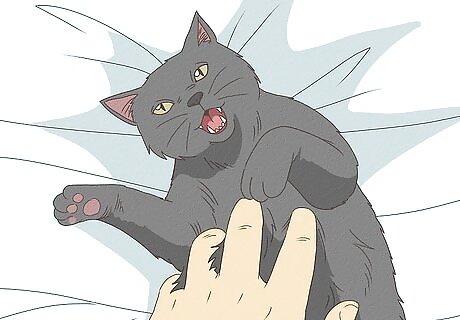
Schedule 2 10-minute play sessions every day. The Russian Blue is a sensitive cat and doesn’t like to be ignored. A lack of attention can cause your cat to become anxious and fearful, so it is important that you spend time petting and playing with your cat on a daily basis. Despite their love of attention, the Russian Blue can also play alone and entertain itself for hours while you are at work.
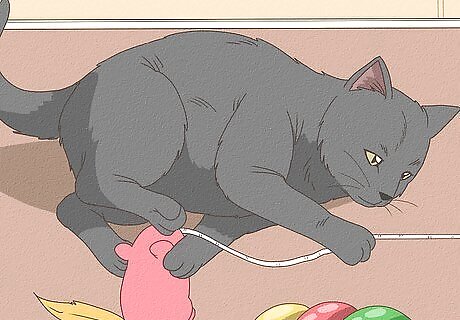
Provide your cat with toys. Russian Blues love to play and are especially fond of retrieving. Some of them will even play catch with you if you toss them a small colorful ball. Make sure that your cat has a variety of toys, such as feather-like toys or toys that mimic mice or birds, to swat and chase.

Purchase scratching posts for your cat. In order to avoid having your cat scratch the furniture, you should have multiple scratch posts situated throughout the house. You could, for instance, have a post in your bedroom and one in the living room. Keeping their nails short will also diminish any damage that comes as a result of scratching.


















Comments
0 comment